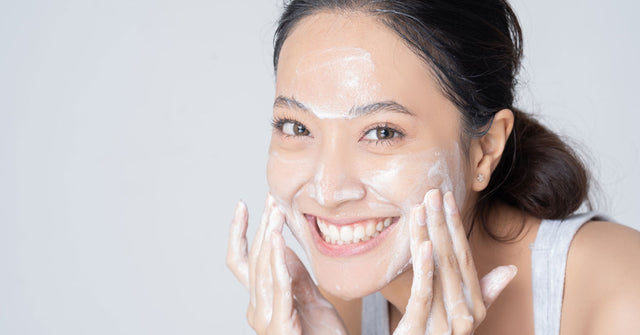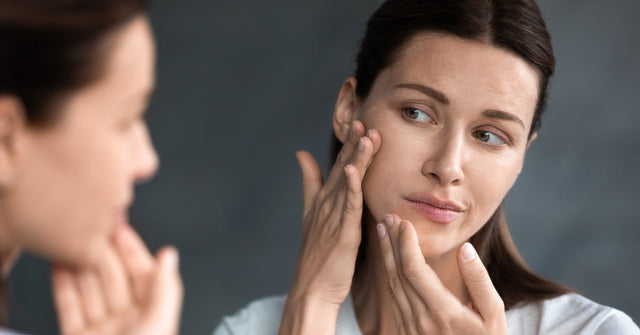A chemical peel for hyperpigmentation involves the application of a solution to your skin to exfoliate and target darkened areas caused by excess melanin production. This procedure promotes cell turnover, reduces the appearance of hyperpigmentation, and reveals a more even skin tone.
The chemical solution usually includes glycolic or salicylic acid, but treatments are customized based on individual skin needs and concerns. In this article, we’ll discuss the benefits of chemical peel treatments for reducing hyperpigmentation.
What is Hyperpigmentation, and How Does It Occur?
Hyperpigmentation [1] is a skin condition characterized by darkened areas or spots due to excess production of melanin, the pigment responsible for skin color. It’s usually a common, harmless concern that can affect people with different skin tones.
Melanin overproduction can result from several factors, including sun exposure, inflammation, hormonal changes, and injury. Methods for managing this issue include protecting yourself from UV rays, topical treatments, or a chemical peel for hyperpigmentation.
What Are the Different Types of Hyperpigmentation?
There are various types of hyperpigmentation [2], and although they are all relatively benign and do not cause harm, dark spots can cause distress to some people who find them aesthetically displeasing. In order to combat this issue, it’s important to understand the different types. These are the main categories:
-
Hormonal Hyperpigmentation: Also called “pregnancy masks” or melasma [3], this type of hyperpigmentation occurs due to hormonal fluctuations that occur during pregnancy, at certain stages of the menstrual cycle, or when taking birth control pills. They appear as individual spots or large patches on the cheeks and chest.
-
Sunspots: Also known as solar lentigines, these harmless patches of darkened skin result from prolonged exposure to UV rays, causing damage that leads to localized darkened areas.
-
Breakout Hyperpigmentation: This post-inflammatory hyperpigmentation (PIH), appears after skin inflammation caused by acne, injury, trauma, or blemishes triggers excess melanin production.
What is a Chemical Peel?
A chemical peel for hyperpigmentation is a cosmetic procedure that involves applying a solution like glycolic or salicylic acid to the skin for controlled exfoliation and peeling. This process removes the damaged outer layer of skin, promoting the growth of new cells for a smoother, brighter complexion.
The benefits of chemical peel treatments include addressing skin issues like hyperpigmentation, acne scars, and wrinkles. The depth of the peel depends on the type and concentration of the chemical used and how quickly you want to see results. Chemical peels are available over the counter in most stores, but we highly recommend that you get a professional treatment from a dermatologist for more powerful results.
Who Should Try Chemical Peels?
A chemical peel for hyperpigmentation [4] is suitable for anyone who wants to improve their skin texture, reduce signs of aging, and promote a healthy complexion. People with sun damage, fine lines, acne scars, or uneven pigmentation may benefit from this treatment, however, it's important to consult with a dermatologist first to determine suitability based on your skin type and health.
Not everyone is a candidate, and individuals with very sensitive skin, infections, or active skin conditions should avoid chemical peels. Using sunscreen to protect your skin from UV rays is essential post-treatment to maintain the results and prevent further damage.
Who Is a Good Candidate for a Chemical Peel?
Typically, the best candidate for a chemical peel [5] is someone who wants to rejuvenate their complexion, improve skin texture, and treat issues like sun damage, acne scars, wrinkles, or uneven pigmentation. However, if you want a chemical peel you should have realistic expectations about the outcome of the treatment.
It’s also important that you have healthy skin. This treatment may not be suitable for individuals with active infections, skin conditions, or a history of keloid scarring. Consult with a dermatologist to determine whether a chemical peel is the right choice for you based on your skin type, health, and medical history.
How Effective Are Chemical Peels For Hyperpigmentation?
Chemical peels help fade hyperpigmentation by exfoliating the complexion and regenerating newer, healthier skin cells. This results in brighter, more textured skin and may also improve the appearance of scars.
Superficial peels that use gentler acids may improve mild hyperpigmentation, while deeper peels address more severe cases. A chemical peel works by removing the top layer of hyperpigmented skin, leading to a more even skin tone. For optimal results, you may require multiple sessions.
The effectiveness of the treatment for you depends on the type and severity of the dark spots, your skin type, and the strength of the peel itself as some chemicals are stronger and can penetrate more deeply than others. It’s essential to wear sunscreen regularly, especially after a peel, to maintain the results and prevent further pigmentation issues.
What Are the Top 4 Ingredients of Chemical Peel For Hyperpigmentation?
There are a variety of different chemical peels for hyperpigmentation, and which you choose depends on the specific results you want and how quickly you want to achieve them. Some chemical peels are mild, while others penetrate the skin deeply.
When deciding on a chemical peel for hyperpigmentation [6], it's essential that you consult with a dermatologist to determine the most suitable treatment and ingredients based on your individual skin needs and concerns.
Glycolic Acid Peel: Glycolic acid [7], derived from sugar cane, is an alpha hydroxy acid (AHA) [8] that is known for its exfoliating properties. It can eliminate dead skin cells, boost cell turnover, and reduce hyperpigmentation revealing a brighter complexion. Glycolic acid peels are effective for addressing sun damage and mild pigmentation irregularities.
Salicylic Acid Peel: Salicylic acid is a beta hydroxy acid (BHA) [9] that is oil-soluble and can penetrate deep into the pores, targeting acne lesions. It is beneficial for treating hyperpigmentation associated with acne and post-inflammatory hyperpigmentation, and it also unclogs the pores, reduces inflammation, and improves skin tone.
Lactic Acid Peels: Lactic acid is another AHA, and it is derived from milk. It’s a mild acid peel that can reduce signs of anti-aging, fade dark spots and hyperpigmentation, and exfoliate the complexion. Lactic acid peels are often recommended for individuals with dry or sensitive skin, as they are quite mild.
Vitamin C Facial Peeling: Vitamin C is a powerful antioxidant known for its brightening properties. Facial peels containing stabilized Vitamin C help reduce hyperpigmentation, protect against free radicals, and promote collagen production. Many people choose this type of peel for its dual benefits of exfoliation and skin brightening. Vitamin C is also highly effective when it comes to protecting the skin against the damaging effects of the sun, therefore is a powerful ingredient for facial peels.
What Are the Benefits of a Chemical Peels For Hyperpigmentation?
There are several benefits of chemical peel treatments that address hyperpigmentation, in particular cases resulting from acne scarring or sun damage.
-
Lightens Dark Spots: Peels help to fade and lighten dark spots caused by hyperpigmentation, for a more even skin tone.
-
Exfoliates: The exfoliating action of a chemical peel removes dead skin cells, boosting cell turnover and revealing a fresh, rejuvenated complexion.
-
Minimizes Sun Damage: Peels can target sun-induced hyperpigmentation, reversing some of the effects of UV damage on the skin.
-
Controls Melasma: Chemical peels, particularly those containing specific acids, can be effective in managing and reducing a form of hormonal hyperpigmentation called melasma.
-
Reduces Fine Lines and Wrinkles: Peels stimulate collagen and elastin production, improving skin elasticity, tightening the complexion, and smoothing fine lines and wrinkles.
-
Fades Acne Scars: Chemical peels can fade post-inflammatory hyperpigmentation, which is commonly associated with acne scars.
-
Balances Skin Tone: By targeting areas of hyperpigmentation, peels contribute to a more uniform and balanced skin tone.
-
Minimizes Pore Size: Peels help unclog the pores and improve skin texture, reducing pore size and promoting a smoother complexion.
-
Improves Skin Texture: The exfoliation and renewal process of a chemical peel improves skin texture, leaving the skin smoother and softer.
-
Easy to Customize: Peels are available in various strengths and formulations, allowing skincare professionals to customize treatments based on individual skin types and concerns.
How to Prevent Hyperpigmentation?
If you want to prevent hyperpigmentation over the long term, it’s important to follow a consistent, comprehensive skincare routine that includes post-peel care. These are some effective skincare and lifestyle tips that can help prevent dark spots from developing.
Apply Sun Protection: Use broad-spectrum sunscreen with at least SPF 30 daily to shield the skin from harmful UV rays, one of the primary causes of hyperpigmentation.
Avoid Peak Sun Hours: Limit outdoor activities from 10 am to 4 pm if possible, as this is when the sun's rays are strongest and can do the most damage to your skin.
Avoid Tanning Beds: UV exposure from tanning beds can contribute to hyperpigmentation, so avoid using them if you want to protect your skin.
Use Glowpeel Dermal Exfoliation and Skin Resurfacing Repair Serum: Incorporate targeted products like Glowpeel to remove impurities and promote skin renewal, both of which can reduce the risk of hyperpigmentation.
Apply Ace-Ferulic Skin Damage Restoration & Photo Aging Defense Serum: This serum is rich in antioxidants that protect against environmental damage, tighten the skin, and help prevent hyperpigmentation.
Exfoliate Gently: Regular but gentle exfoliation removes dead skin cells, preventing uneven pigmentation. However, limit treatments to 1-2 times a week as exfoliating may irritate the skin and worsen hyperpigmentation.
Use Maxatone Clarifying Toner: Using a toner like Maxatone as part of your daily skincare routine can help balance pH levels and promote a clearer, more revitalized complexion.
Moisturize Regularly with Infusoderm Deep Hydration Daily Moisturizer: Using Infusoderm daily can keep the skin well-hydrated and support its natural barrier function, while also moisturizing dry skin and brightening the complexion.
What is the Difference Between an Acne Peel and an Acne Scar Peel?'
It's important to note that the chemical peel you choose should be based on your specific skincare needs. Usually, it is best to consult with a dermatologist to determine the best treatment option based on the severity of your acne and scarring.
The main purpose of a chemical peel for acne is to control and manage active breakouts. This type of peel usually contains ingredients like salicylic acid to penetrate the pores, reduce oil production, and exfoliate, helping to prevent new acne lesions. In many cases, it requires several sessions to get bad acne under control. The main outcome is the reduction of active acne lesions and the prevention of new breakouts.
Chemical peels for acne scars improve the appearance of post-inflammatory hyperpigmentation and acne blemishes on the surface of the skin. These peels often contain ingredients like glycolic acid to promote exfoliation, stimulate collagen production, and fade hyperpigmentation associated with scarring.
As they target long-term improvement rather than immediate results, chemical peels for acne scars are less common than peels for active acne. The primary outcomes are reducing hyperpigmentation, improving skin texture, and fading acne scars.
How Do Chemical Peels For Acne And Acne Scars Work?
Chemical peels for acne contain ingredients like salicylic acid to penetrate the pores, reduce oil production, and exfoliate, preventing new acne lesions. In a series of sessions, they primarily target active acne breakouts by healing pimples, reducing inflammation, unclogging pores, and preventing new breakouts.
Chemical peels for acne scars contain glycolic acid which exfoliates, stimulates collagen production, and fades hyperpigmentation associated with scars. They improve the appearance of post-inflammatory hyperpigmentation and superficial acne scars, enhance skin texture, and minimize the visibility of acne scars over the long term.
Frequently Asked Questions
Will a chemical peel remove acne scars?
A chemical peel can improve the appearance of acne scars by exfoliating the skin and stimulating collagen production. A superficial peel that includes ingredients like glycolic acid may help fade hyperpigmentation and enhance skin texture. However, deep or pitted scars may require a more aggressive treatment like laser therapy.
It's essential to consult with a dermatologist to determine the best approach for you based on the type and severity of your acne scars. While chemical peels can help reduce scars, it may require multiple sessions and in some cases, you may not be able to completely eliminate them.
Are chemical peels suitable for all skin types and tones?
Chemical peels are suitable for various skin types and tones, but individuals with darker skin may be at a higher risk of developing post-inflammatory hyperpigmentation. A dermatologist can tailor the peel to the specific needs of each individual, adjusting the type and concentration of acids used. People with sensitive or damaged skin should approach chemical peels cautiously.
What is the best age to get a chemical peel?
The ideal age to get a chemical peel varies based on individual skincare needs. While peels can benefit individuals in their 20s by addressing concerns like acne or uneven skin tone, they are also effective for anti-aging purposes in the 30s and beyond.
You should make the decision based on your specific skin issues and needs rather than on your age. It's important to consult with a dermatologist to assess your skin health and concerns before you get a chemical peel, as they can recommend the most appropriate timing and type of peel based on individual factors.
Are chemical peels safe for everyone?
Chemical peels are not safe for everyone, and in particular Individuals with certain skin conditions, infections, or a history of keloid scarring should avoid them. People with dark skin tones may be more prone to pigmentation issues post-peel. In addition, women who are pregnant or breastfeeding should avoid the stronger peels.
Professional guidance from a dermatologist or skincare expert is essential to determine the right peel for you based on skin type, concerns, and medical history. Proper post-peel care, including sun protection, is vital to minimize risks. Overall, safety depends on individual factors, and consultation with a skincare professional is paramount.
Conclusion
A chemical peel for hyperpigmentation is a skincare treatment that can address various concerns, from acne to signs of aging. While generally safe, whether this treatment is suitable for you depends on individual factors, and people with certain skin types and conditions should avoid peels.
We recommend that you consult with a dermatologist or skincare professional to ensure personalized recommendations and minimize potential risks. A chemical peel can be an effective method for improving skin texture and appearance, but an informed and tailored approach, including proper pre and post-peel care, is essential for achieving optimal results safely.
References
1] ↑https://www.aocd.org/page/Hyperpigmentation#
2] ↑https://www.shanidarden.com/blogs/shanis-skin-care-tips/chemical-peel-for-hyperpigmentation
3] ↑https://www.ncbi.nlm.nih.gov/pmc/articles/PMC3560164/
4] ↑https://www.webmd.com/beauty/cosmetic-procedures-chemical-peel-treatments
5] ↑https://www.healthline.com/health/beauty-skin-care/hyperpigmentation-treatment
6] ↑https://www.dinastrachanmd.com/blog/chemical-peels/chemical-peel-for-hyperpigmentation-7-top-ingredients/
7] ↑https://www.halecosmeceuticals.com/product/glycolic-acid#
8] ↑https://www.dinastrachanmd.com/blog/a/general-dermatology/bha-vs-bha/
9] ↑https://www.dinastrachanmd.com/blog/a/general-dermatology/bha-vs-bha/
Mentioned in this article
More stories

Cleanser: A Comprehensive Look at the Basics of Skincare






